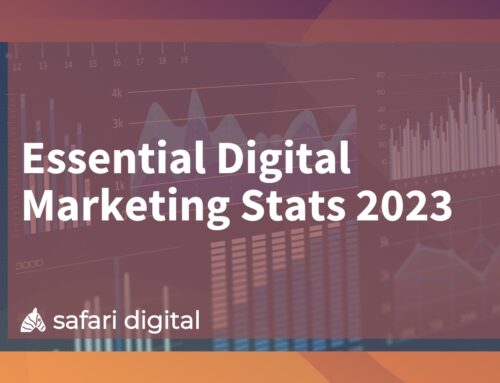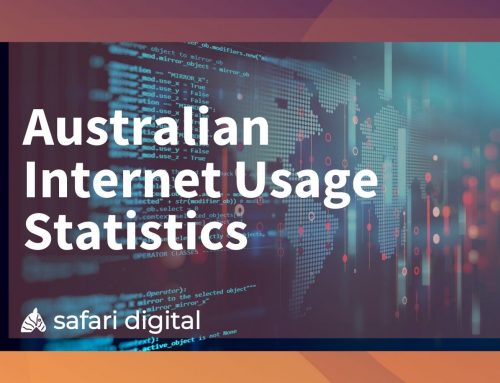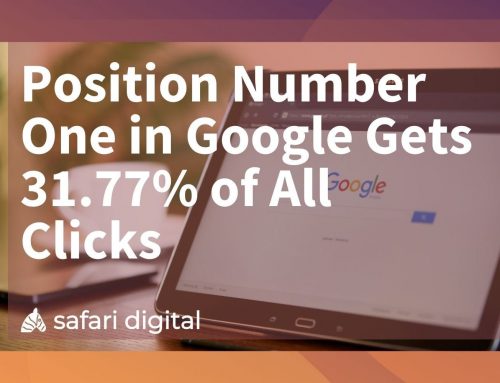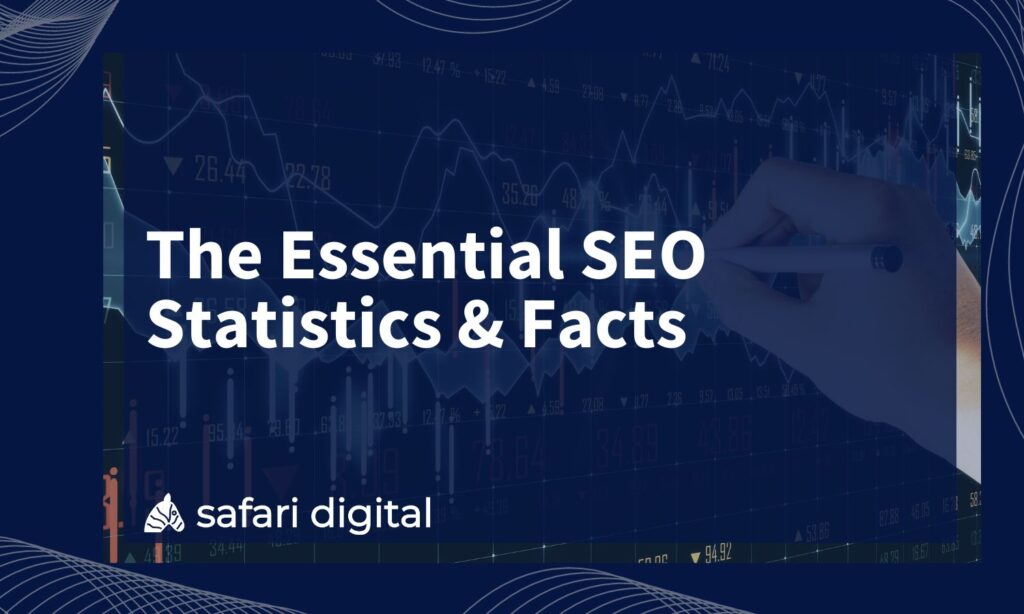
Explore 62 essential SEO statistics and facts that you should care about in 2024 with our vetted, verified list of search engine optimisation statistics and insights.
Whether you’re an experienced SEO professional, or a digital marketing newbie looking to understand the role and value of organic search marketing, our list of trends and insights are essential reading.
For easy reading, explore SEO stats by general, local, mobile, social media, content marketing, and tech-driven trends.
General SEO Statistics
1. Google continues to be (by far) the most popular search engine.
Google accounts for more than 91% of total search engine traffic, followed by Bing at 3.19%, Yandex 1.52%, Yahoo 1.33%. Duck Duck Go 0.62%. The remaining search traffic is spread amongst ASK.com, AOL and other smaller players.
2. 50% of all organic search queries include four of more words.
This point is particularly important for websites that are not making the most of longtail keywords. Not only are longtail keywords important for web traffic, they also have a higher conversion rate than general search enquiries.
3. Quality Content and Link Building are the key to SEO success.
According to multiple authoritative sources, the combination of high-quality content and link building is the most effective way to rank content in search engines. When combined, link building and good content have the potential to catapult web traffic.
4. 61% of marketers believe that SEO is the key to online success.
The ongoing benefits of search engine optimisation are the reason for SEO being ranked as the most effective way to increase awareness, traffic, and grow online.
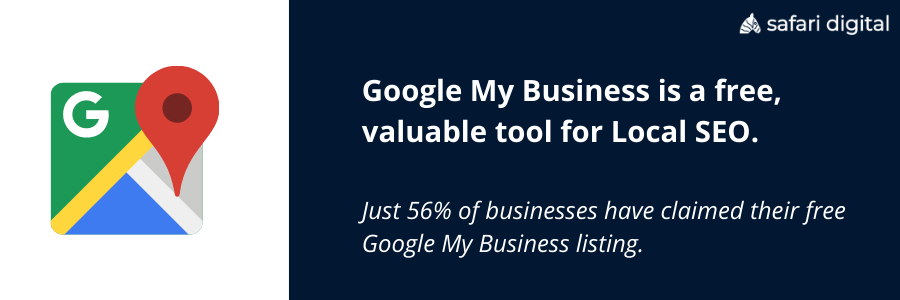
5. Updating an existing title tag with an SEO optimised one can increase page clicks by more than 437%.
A test carried out by Safari Digital in May of 2022 found that updating existing, previously written articles with an optimised title tag that brought the article into line with keywords with search volume behind them can increase page clicks by more than four times. The study which was carried out across 16 websites on more than 135 web pages found that pages with an updated, optimised title tag received on average 107% more clicks than pages that were not updated.
6. Just 0.83% of Clicks go to Websites on Page 2 of Google.
It’s a scary thought, but if your website is not on page 1 of Google, you have less than 1% chance of receiving an organic click when a user conducts a Google search. This statistic highlights the overwhelming value and importance of getting to page 1 of Google for the search terms that are going to make a tangible difference to your bottom line. While it is still possible to rack up a considerable number of impressions on page, your chances of getting a click are remote.
7. 56% of businesses allocate less than one-quarter of their marketing budget to link building.
Just like every other aspect of business, with link building, you get out exactly what you put in. Companies in tune with the importance of SEO understand that getting to the top (and staying there) of the search engine results pages requires a significant investment time, money, and patience. It’s important to recognise that unlike PPC advertising, SEO will continue to work around the clock to attract leads to your businesses long after the campaign has finished.
8. Businesses with a marketing strategy allocate on average 41% of their budget to SEO
. Attracted by the residual and ongoing benefits of an SEO strategy, businesses are spending more than ever to increase their exposure through organic search. This number is expected to grow to more than 45% over the coming 12-months.
9. Longtail keywords encourage higher click through rates (CTR).
This search fact reveals that longtail keyword searches enjoy a 3-5% higher CTR in the organic search results than organic search titles with 1 or 2 words in the title.
10. 70% of clicks in Google search results go to organic, with 30% going to AdWords.
While PPC marketing plays an important role in a holistic marketing strategy, there is no doubting the effectiveness of organic search results. Despite Google’s best efforts, users are still very aware of what is a ‘paid’ and what is an organic listing in the search results. SEO statistics like this one make a strong argument for allocating more resources to SEO in a marketing budget.
11. Businesses with online reviews are trusted by 73% of consumers.
Social reviews through Google My Business, Facebook, Yelp and other peer to peer review platforms are a highly effective way to boost user trust and drive conversions. Businesses who displayed links to reviews directly on their website using schema mark-up are even more likely to encourage users to make a purchase.
12. 97% of consumers research a company via the internet.
Consumers have access to more information than ever. This SEO fact highlights the importance of having an abundance of company information available online for potential customers. Make it easy for your target market to learn about your company by offering up information about your company and your story through your website.
13. 65% of digital marketers admit that link building is the most difficult aspect of SEO.
Search engine optimisation is constantly evolving. Google is becoming more sophisticated in understanding the origin of links and how much value to place on them. Link building is rated as the most difficult and unpredictable aspect of SEO. Google is constantly changing the weight that it gives to links. In 2024, marketers need to ensure that they are building clean, sustainable links that will remain safe and unaffected through Google’s future algorithm updates.
14. 34% of companies allocate more than $1,000 per month to their link building efforts.
Worried about how much money and effort your competitors are putting into their search engine optimisation strategy? The latest research suggests that companies are spending more than $1,000 USD per month on link building to boost and sustain their position in the search engine results pages. With a growing awareness of SEO, businesses who are at the top of the search engines are working hard to defend their position by adding new, relevant links to their websites each month.
Local SEO Statistics
Getting to the top of the SERPs was once considered a pipe dream for small to medium businesses. In a landscape that was dominated by big players with even bigger budgets, Google found a way to give smaller businesses a chance to capture a local and highly lucrative audience. In July 2014, Google unveiled the first iteration of their Pigeon update which gave local businesses the chance to compete with their more established rivals at a local level. The update meant that Google started giving preference to businesses that were in close proximity to the user.
Google’s Pigeon SEO update gave local businesses a lifeline in an increasingly competitive SEO landscape. Since then, local businesses have been thriving in the local search engine results. Here are a few of the most important local SEO statistics for 2024.
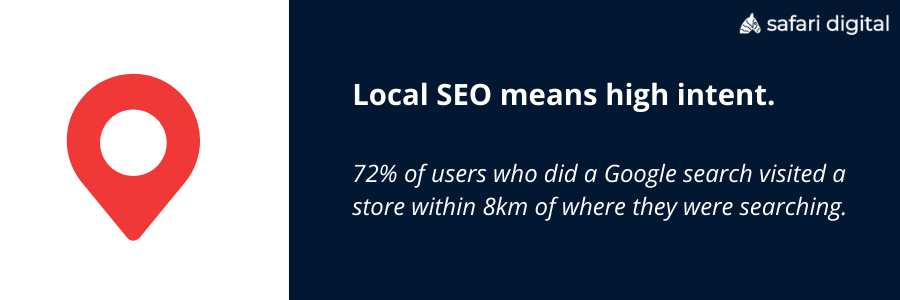
15. 72% of users who did a Google search visited a store within 8km of where they were searching.
Local SEO is a highly effective way to drive motivated traffic to your business. Make the most of Google My Business and implement a Local SEO strategy to ensure you’re getting seen by customers in your area.
16. 46% of all Google searches feature a local intent.
The latest local SEO statistics show that almost half of all searches that take place on Google feature a local SEO intent. Google is placing more emphasis on delivering local results that provide an immediate solution for customers. Companies that neglect a comprehensive local SEO will continue to fall by the wayside.
17. 28% of searches that include local intent will result in a purchase.
Another search engine optimisation fact that needs little explanation. For businesses of all sizes, the importance of a local SEO strategy cannot be overstated.
18. 56% of local businesses have not claimed their Google My Business listing.
Businesses who have not claimed or configured their free GMB listing are missing one of the most fundamental aspects of an effective local SEO strategy. Given that GMB is one of the first things that users will see when searching a business on Google, it is vital to have your business listed, verified, and managed.
19. “Near Me” searches have increased by more than 130%
Google users love to include a “near me” search in whatever they are looking for. Whether they are looking for:
• “Petrol Station Near Me”
• “Café Near Me”
• “Restaurant Near Me”
• “Electronics Store Near Me”
Over the last five years, the number of users include a “near me” classification at the end of their search query has grown by more than 500%. At a time when more than half of all searches come from a mobile device, users are looking for a local solution to their problem. In 2024, small businesses have the ability to captivate a local audience with a comprehensive local SEO strategy that targets local, highly-motivated users.
20. More than 50% of all “Near Me” searches result in an offline conversion.
Not only are “near me” searches on the rise, but they also deliver staggering conversion rates. The addition of these two simple words, “near me”, unlocks a world of local, highly-relevant results. More than half of all users who conducted a “near me” search last year went on to purchase goods or services or visit an establishment within 24-hours of conducting that search. This local SEO statistic further proves the importance of local search intent and demonstrates the value of a local approach to search engine optimisation.
21. 88% of users seek online reviews for local businesses.
There are no two ways about it – local users love to read reviews and assess the quality and value of a business based on independent reviews. Online reviews are a great way to show off a proven track record of satisfied customers. A staggering 88% of consumers admitted to reading reviews before engaging with a local business. Genuine, positive reviews from satisfied customers build trust with new, prospective customers. Social proof is a great way to build legitimacy with your prospective customers.
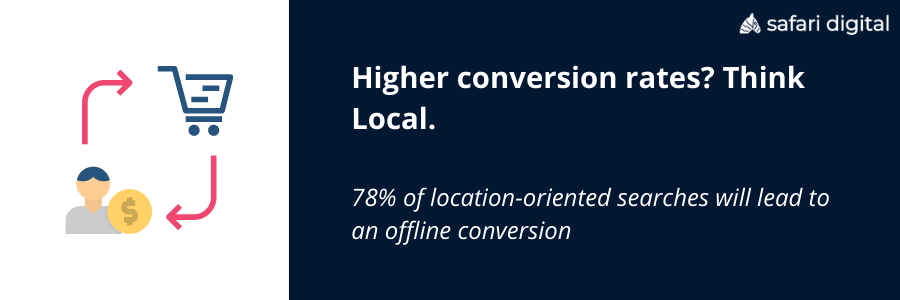
22. 78% of location-oriented searches will lead to an offline conversion
. Immediate gratification means that bricks and mortar businesses are still alive and well. According to the latest SEO data, 78% users who make a search that includes location information will then carry out that transaction in a physical store. Even for businesses who thrive on sales in bricks and mortar locations, it’s essential to have an SEO strategy in place that exposes your business to potential customers.
23. 82% of businesses have not claimed their Bing Business listing.
According to the latest SEO statistics, Bing accounts for 7.27% of total web searches. While this number is dwarfed by Google, businesses who have not taken the time to configure and optimise their Bing Business listing are neglecting more than 7% of their potential market share. For some niches, the % of users who access their business through Bing could be considerably higher.
Mobile SEO Stats
Still not convinced mobile-friendly sites are important for SEO success? The most recent data shows that mobile search is the most common way that users interact with Google (and the internet as a whole). Mobile search rankings are more important than ever, which means that your website needs to be intuitive, easy-to-use, and above all, provide a seamless mobile experience for users. Here are the most important mobile SEO stats to get your head around.
24. 30% of Google searches from a mobile device include a location.
The latest SEO statistics have revealed that almost 1/3 of all searches that come from a mobile device specify a location. This surprising SEO fact highlights the importance of a Local SEO strategy that targets local, highly lucrative traffic.

25. 92% of mobile phone users will access the internet from their mobile device.
Unsurprisingly, the number of people accessing the internet from their mobile phone is on the rise. Improved mobile infrastructure and devices has paved the way for mobile devices to become the most popular way to access information. The number of smartphone users globally is more than 6.64-million.
26. 69% of mobile device users say that they are more likely to buy from a website that addresses their questions easily.
This SEO statistic should come as no surprise to anyone. Websites that address user queries and provide ease of access from mobile devices are far more likely to land a conversion than those that do not.
27. The cut off load time for a mobile device is 5 seconds.
When it comes to SEO, speed matters. The latest SEO data reveals that mobile sites that take more than 5-seconds to load have a 70% lower mobile session rate than those that load in under five seconds. According to Google, a delay of one-second can mean a 20% drop in conversion. If you’re still on the fence about optimising your website for speed, this is one of those SEO statistics that you cannot ignore.
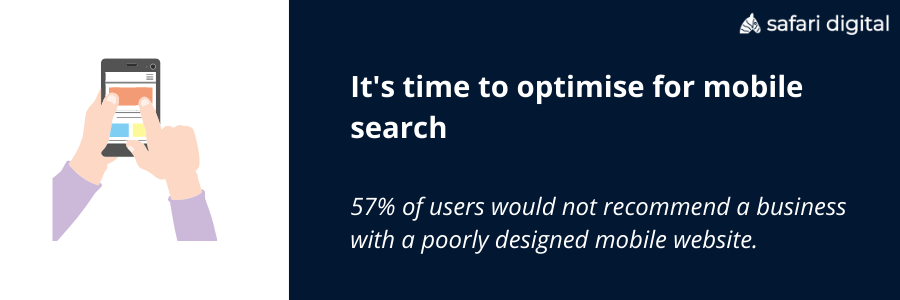
28. 57% of users would not recommend a business with a poorly designed mobile website.
Users have more choice than ever, which means that they can afford to be pickier than ever before. According to Google, users who are not able to read or browse content efficiently and effortlessly on their mobile device are likely to abandon the page. Not only will websites lose that user, they also run the risk of users warning their peers against using their website in the future.
29. More than 30% of all mobile searches were made right before visiting a store.
SEO statistics reveal that almost one third of users visited a store after completing a search from their mobile phone. This SEO statistic highlights the importance of making your business visible in the organic search results when trying to attract new customers. This fact also highlights that bricks and mortar businesses still play an important role in the buying economy, as well as the importance of having a strong online presence – even if the majority of sales still come through a physical store front.
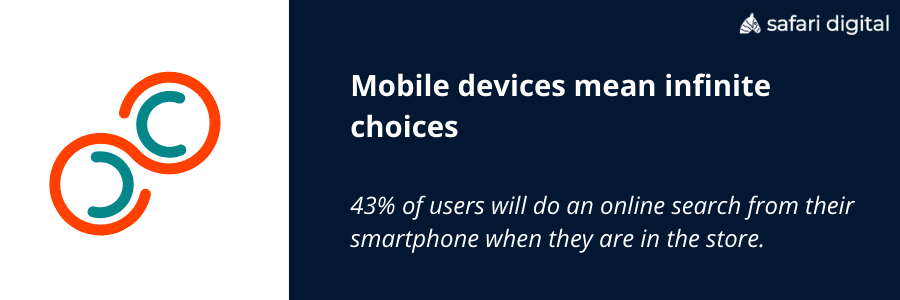
30. 43% of users will do an online search from their smartphone when they are in the store.
The latest SEO statistics show that customers are taking no chances when it comes to spending money at bricks and mortar locations. Consumers have more choice than ever, and as a result almost half of all consumers still use their smartphone to confirm their purchasing behaviour even when they’re in a physical store that sells their desired product. Exposing your business to customers through SEO can be vital right up until the moment of the sale.
31. 66% of E-Commerce browsing time comes from mobile, however, less than 30% of sales come from mobile devices.
Mobile devices are increasingly being used to browse online stores; however, users are still wary when it comes time to making a sale. Ease of access and greater visibility means that mobile devices are still surpassed by desktop and laptops when it comes time to make a purchase.
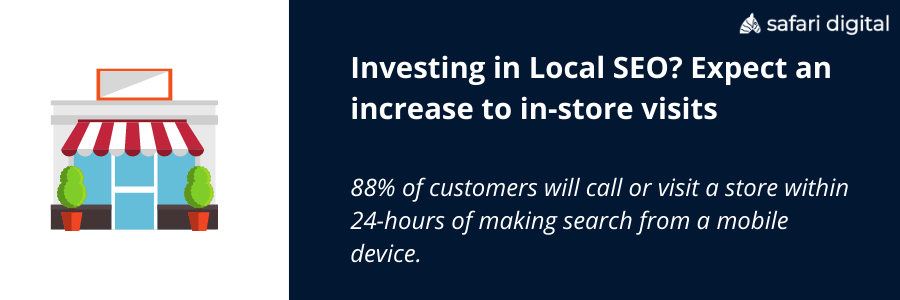
32. 88% of customers will call or visit a store within 24-hours of making search from a mobile device.
This SEO statistic highlights the fact that businesses who make themselves visible through local SEO and mobile optimisation will, in most cases, be the business that receives an enquiry from a potential customer. Failing to implement an effective local SEO strategy is a sure-fire way to ensure your business will miss out on potential customers.
33. 60% of all Google searches are done through a mobile device.
We know that mobile traffic eclipsed desktop traffic back in 2016, but the most recent SEO statistics also reveal that more than half of all Google searches come from a mobile device. By way of a comparison, in 2014, just 34% of all Google searches came from a mobile device. The growth of the smartphone, mobile data, and improved mobile UX can all be attributed to the dramatic rise in Google mobile searches.
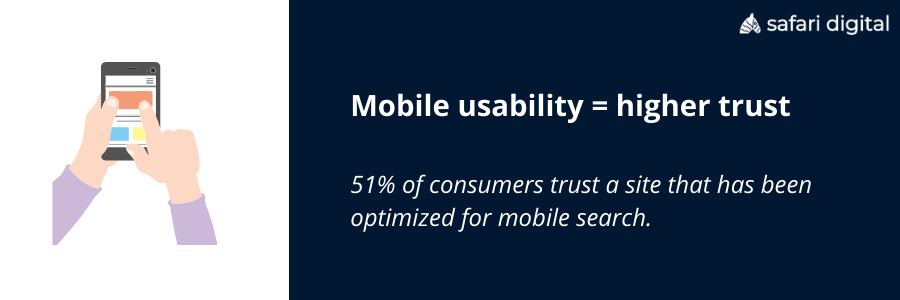
34. 51% of consumers trust a site that has been optimised for mobile search.
Google revealed in 2018 that mobile first indexing would replace desktop first indexing in 2024. The latest consumer statistics reveal that having a mobile-friendly website is now more important than ever with users placing a greater emphasis on websites that have been optimised for search and use on a mobile device.
35. Mobile e-commerce sales will far outweigh desktop.
It wasn’t long ago that mobile devices made up just a fraction of total online sales. The growing use of mobile devices and the optimisation of mobile usability from Ecommerce websites mean that users are expected to favour mobile devices. The stats reveal that businesses with a mobile ready website are far more likely to be successful online.
Social Media SEO Stats
36. Social media links are not the same as backlinks.
Despite the importance of having a strong presence across the most popular social media platforms, Google have confirmed that links from Facebook, Instagram, Twitter, Pinterest, and other popular social media platforms do not carry the same weight as a traditional backlink.
37. Search engines are 10 times more effective than social media at driving traffic to shopping sites.
SEO is the most effective way to drive high-converting traffic. The most recent search engine statistics reveal that search is the most dominant traffic source for shopping sites. For Ecommerce businesses, this SEO stat highlights the importance of having a search engine optimisation strategy in place. That means adding proper page titles, descriptions, H-tags, meta descriptions, backlinks, optimising for site speed, and conducting thorough keyword research.
Content Marketing Statistics
38. Updating existing content with fresh images and written content can increase organic traffic by 111.3%.
The hard work doesn’t stop once you hit the publish button on a post or set a new page live. Republishing and updating existing content is one of the most time-effective SEO strategies for increasing organic reach.

39. Content is still king in SEO.
The old saying still rings true in the latest search marketing statistics. According to the latest information, 57% of SEO experts rank content creation and content marketing as the #1 way to drive the best results in search marketing. According to the same SEO stats, social media marketing and backlinks rank as the #2 and #3 more effective ways to increase traffic.
40. The average page 1 result in Google contains 1,890 words of content.
This is one SEO statistic that keeps content marketers up at night. According to the latest SEO research, the average page 1 result of Google is almost 2,000 words. Detailed articles and landing pages will also position your business as an industry leader – not a follower. Not every page needs to be lengthy, however, competitor research should help marketers to uncover which posts require more content than other in order to rank in Google.
41. 72% of marketing experts believe that relevancy is the key to a successful SEO campaign.
Search engine optimisation experts rarely agree on the most effective search marketing tactics; however, this is one SEO stat that almost three-quarters of them can agree on. Search marketing experts believe that relevant content improves search ranking potential and is an effective way to generate meaningful, natural backlinks.
42. Content creation improves indexation rates by more than 434%.
Google loves websites that are regularly updated. In order to pass that love back to webmasters who constantly update their website, Google will rank their content higher and index pages faster. The latest blogging SEO stats show that creating blog content on a regular basis will result in 434% higher indexation rates than websites that do not regularly update their content. The key to a successful content marketing campaign is to create content that addresses the questions that your users are asking. Google search console ‘queries’ function is a highly effective way to see how users are finding and interacting with organic content on a website.

43. Less than 40% of marketers are publishing content once per week.
This mind-boggling SEO statistic reveals that despite knowing the power of content marketing, just 38% of marketers are posting content once or more per week. Marketers understand and recognise the potential of content for improving brand awareness and reach but lack the resources to consistently publish content. A successful organic search campaign means committing to publishing high-quality, regular, relevant content. Successful search marketing is a culmination of months and years of ongoing work.
Technology Driven SEO Trends
Technology and emerging search trends are revolutionising the search engine optimisation landscape. The increased access to information, mobile device usage, and a growing network of connectivity means that users are now more connected than ever. So, how is technology changing the way that SEO operates? We’ve found the most interesting technology SEO stats that you need to know about.
44. More than 50% of search engine use will include a voice or image search
This surprising SEO statistic highlights the growing trend of voice search as AI devices like Apple’s SIRI, Amazon’s Alexa, and Google Home play a more important role in the way that users access information.
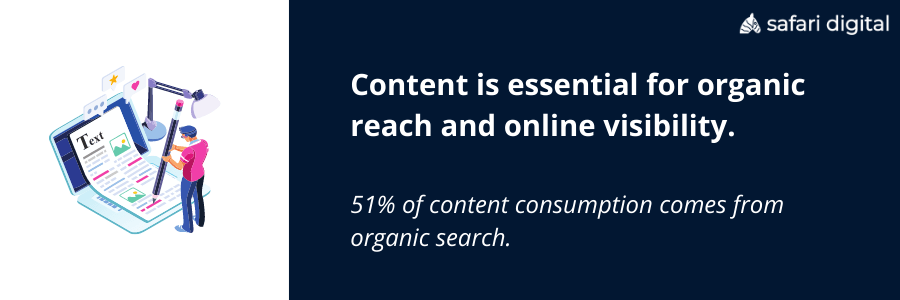
45. 51% of content consumption comes from organic search.
If you’re on the fence about implementing an SEO strategy, this SEO statistic should tell you everything you need to know about the importance of an organic marketing strategy. More than half of all content on the web is accessed through an organic search.
46. 27% of users are already using voice search on Google.
Voice search has been a buzz word in the SEO community for almost a decade. The vast array of virtual assistants from Apple, Amazon, Samsung and Google (just to name a few) mean that voice search is now simples than ever before. Webmasters and marketers need to place an added emphasis on this emerging trend by optimising their content and schema mark-up for voice search.
47. Positive reviews result in a 91% increase in trust in young people (18-34)
. The latest SEO facts indicate that websites that receive positive reviews on social platforms such as Facebook, Instagram, Yelp, TripAdvisor and Google My Business are 91% more likely to be trusted (and used) by young people. This search trend reveals just how important it is for business owners to monitor and source reviews for their business.
48. Video content is 5 times more likely to drive a conversion than content alone.
It is a long-established fact that video content is a good way to drive conversion with visitors, however this surprising SEO fact reveals the importance of video content. Videos are a more effective way to attract and retain visitors. Ensuring that the video content is properly optimised for SEO is also an important factor in the performance of your content.
More Powerful SEO Statistics
Still sitting on the fence about SEO? These important SEO trends reveal just how important search engine optimisation.

49. 92% of traffic goes to the results on the first page of Google.
It’s a scary thought but highlights just how important an SEO strategy is for the success of your business. More than 9 out of 10 users will select a result from the first page of Google. If you’re on page 2 or 3 of Google, your chances of being found are extremely low.
50. 70% of users trust information that they find online.
Remember the days of calling ahead before visiting a store? According to the most recent data, a staggering 70% of users implicitly trust the information that they find online when it comes to business location, opening times, stock and availability. It’s more important than ever to ensure all of your business information is consistent and up to date.
51. 82% of people who implemented an SEO strategy said that it had a positive effect on their business.
Of that number, 45% of business owners interviewed said that the effectiveness of SEO was increasing.
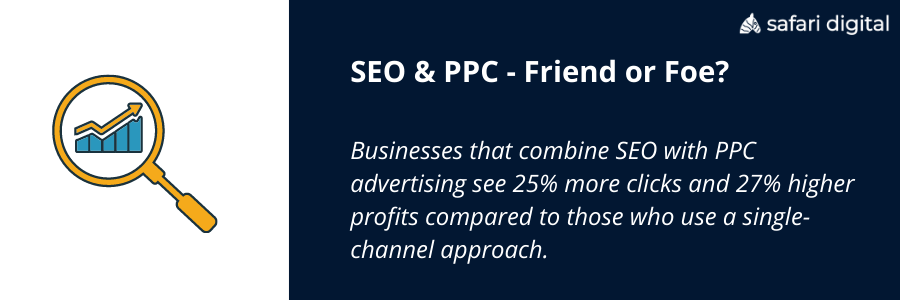
52. Businesses who combine SEO with PPC advertising see 25% more clicks and 27% higher profits compared to those who use a single-channel approach.
A good SEO strategy should go hand in hand with a PPC marketing campaign. Given that most SEO strategies will involve creating highly specific landing pages, it makes sense to repurpose this content in your Google AdWords or Facebook Advertising campaign.
53. SEO is 5.66 times more effective than paid search advertising.
Search engine optimisation is still considered to be the most effective digital marketing strategy for this reason. Users are more trusting or search results than they are of advertisements shown to them by Google. There is a sense that companies can buy their way to the top of the search results, but the ones that are worthy of your business are those that can earn their way to the top. In 2024, users are also more in tune with which results are ‘paid’ and which are organic.
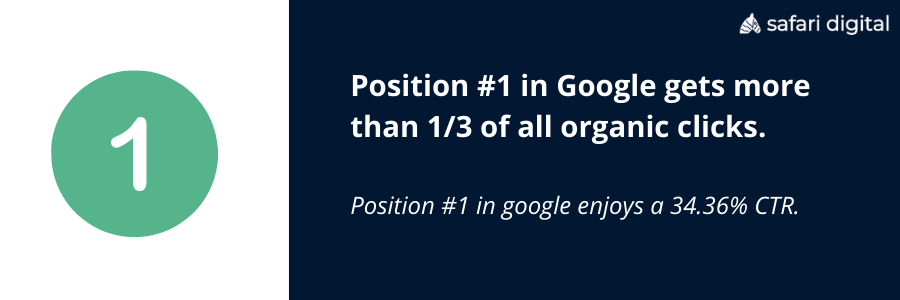
54. Position #1 in google enjoys a 34.36% CTR.
This is one SEO statistic that should drive home the importance of getting to number one on Google. Businesses at the top of Google will receive a click through rate of more than one-third. As you move down page one to positions 2-9, the click-through rate drops significantly.
55. The top three organic results in Google command 61.8% of all clicks
The top 3 organic search results in Google account for more than sixty percent of total clicks (paid and organic). We know that page 1 of Google accounts for more than 98% of all organic search clicks, but those numbers are largely skewed by the top three results which command a significant portion of this search traffic.
56. Pages with videos are 53% more likely to be displayed on page 1 of Google
. Still not convinced you need video in your SEO strategy. Think again. The latest data suggests that web pages with videos on them are 53% more likely to show up on page one of Google than those that do not. While video content is important, it’s important that the video does not inhibit the user experience and that webpages can still load quickly.
57. 75% of users will not scroll past the first page on Google.
Are you still not convinced of the power of page 1 results on Google? This is one of the most jarring SEO statistics for anyone stuck on page 2 or 3 of the search engine results. Page 1 rankings are not only attractive to users because they are viewed as being more trustworthy, they also get significantly more impressions than those on page 2, 3 or 4 of Google. A staggering three-quarters of users admit that they do not go beyond page 1 when looking for information.
58. 21% of users will view more than one page in the search results.
Users have a plethora of information at hand when it comes time to make a decision. Today, more information is being consumed and reviewed in the decision-making process. Users are most likely to check multiple sources in the search engine results pages when they cannot find what they were looking for or if they want to affirm any information that they have found.
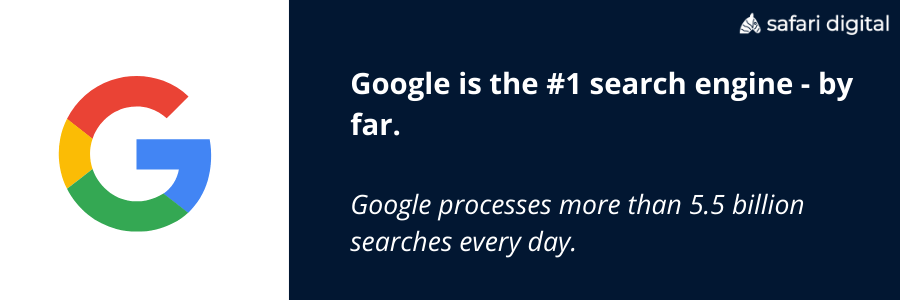
59. Google processes more than 5.5 billion searches every day.
That’s a lot of questions being answered! The latest search statistics reveal that in 2018 Google handled more than 5.5 billion search queries every single day. This number jumped significantly from 2010 when Google handled 1.9 billion queries each day. The enormous rise in search engine traffic can be attributed to increased internet usage and ease of access through mobile smartphone devices.
60. Google handles more than 63,000 search queries each second.
This staggering search statistic reveals just how much information Google is processing each day. With almost 4-million searches per minute and 2 trillion each year, Google is by far the busiest website on the web.
61. The average duration of an initial SEO campaign is 11.4 months
Using more than three years of Agency data, Safari Digital found that the average duration of an initial SEO campaign was 11.4-months with 89.3% of businesses opting to invest in search engine optimisation for a period of more than 24-months. The data found that most customers saw a tangible return on investment using an SEO ROI calculator within the first 4.3-months of their SEO campaign.
62. The biggest pain point for customers working with an SEO agency is communication
An inbound ‘new client survey’ from Safari Digital found that 64% of clients that had previously worked with an Australian SEO agency cited a lack of communication as the biggest pain point for continuing an SEO campaign. While 37% of customers cited a lack or results or a regression in SEO visibility as a catalyst for switching agencies.
Let’s Wrap it Up
That’s more SEO statistics than you can poke a stick at. These data-proven search engine optimisation stats and trends should help you to make informed decisions in your next SEO campaign. Remember, understanding your market is the key to uncovering what is required to reach the coveted page 1, position 1 spot in the SERPs. Want help with your SEO Strategy? Talk to the SEO Sydney Experts at Safari Digital today.
Related Statistics Articles
Browse some of our most popular statistics articles



